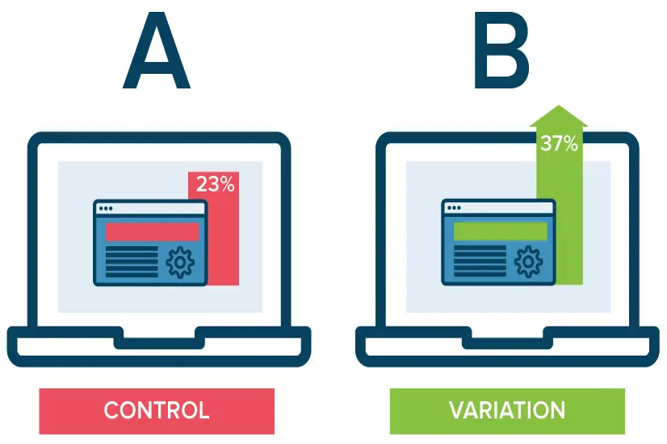The Importance of A/B Testing in Digital Marketing

A/B testing involves creating two versions of a digital asset to see which one performs best. Examples of assets are landing pages, display ads, marketing emails, and social posts. In an A/B test, half the audience gets “version A” and half gets “version B.” The performance of each version is based on conversion goals, like the percentage of people who click a link, fill out a form, or make a purchase.
A/B testing isn’t a new concept in digital marketing. Back in the day, direct mail was the king of “split testing” or “bucketing” offers to see which one worked best. Digital just builds on the same idea but allows for more specific, more reliable and faster test results.
You’re trying to grow your business but can’t figure out which marketing assets resonate with your audience. A/B testing (along with other conversion optimization techniques) lets you try things out so you can improve your content, deliver the best customer experiences, and reach your conversion goals faster. This A/B testing guide by FOR® will teach you the importance.
How do You Conduct an A/B Test?
When all is said and done, A/B testing is just the scientific method. If you want to get the most out of it, you need to approach it scientifically. Just like the lab version of the scientific method, A/B testing starts with what to test. The whole process is several steps:
Identify the Problem
Make sure you pick a specific problem. “Not enough conversions” is too broad. There are too many variables that go into whether a website visitor becomes a customer or an email recipient clicks through to your site. You need to know why your content isn’t converting.
Example: You work for a women’s clothing retailer that has a lot of online sales, but very few of those sales come from your email campaigns. You go to your analytics data and see that a high percentage of users are opening your emails with special offers and reading them, but few are actually converting.
Analyze User Data
You could technically A/B test everything your customers see when they open your emails but that would take a long time. There are a lot of design and content elements they see that aren’t relevant so you need to figure out what to test.
Example: People are opening your emails so there’s nothing wrong with your subject lines. They’re also reading them so there’s nothing that’s making them click away. Because a lot of users who find your site from elsewhere become customers, you know there’s nothing wrong with how you’re presenting your products. So it means people find your emails compelling but are getting lost when they actually click through to your site.
Conduct the Hypothesis Testing
Now you’re really getting specific. Your next step is to decide what you want to test and how you want to test it. Narrow down your unknowns to 1 or 2 at least to start. Then you can figure out how changing that element or elements will fix the problem you’re facing.
Example: You notice the button to go to your online store is at the bottom of the email below the fold. You think if you move it to the top of the screen you’ll be able to get more people to visit your site.
Test the Hypothesis
Create a new version of the test item that implements your idea. Then A/B test that version against your current page with your audience.
Example: You create an email with the button above the fold. You don’t change the design just the position. You decide to test for 24 hours so you set that as your time parameter and start the test.
Benefits of A/B Testing for Digital Marketing
A/B testing is a powerful technique that can offer several benefits for digital marketing. Here are some of the key benefits:
Improved Conversions: A/B testing helps you optimise your marketing campaigns for better conversions. By seeing which version performs better you can adjust to get more conversions.
More Engagement: By testing different marketing campaigns you can see which one resonates with your audience. This means more engagement from users and better customer experience.
Data-driven: A/B testing helps you make data-driven decisions about your marketing campaigns instead of assumptions and guesswork. This means you can improve your campaigns based on real data, which means better results.
Better ROI: Optimizing your marketing campaigns through A/B testing can improve your ROI. You can see which campaigns are working and allocate your resources accordingly.
Less Risk: A/B testing allows you to test your marketing campaigns on a small part of your target audience before rolling out to the full audience. This means you can reduce the risk of a campaign failing and minimise any negative impact on the brand.
Conclusion
In summary, A/B testing has many benefits for digital marketing: higher conversion rates, more engagement, data-driven decisions, better ROI and less risk. By leveraging these benefits, you can optimise your marketing campaigns and grow.
A/B testing is a quick and easy way to test your audience’s response to a design or content idea without disturbing your users or sending out annoying feedback surveys. Test different design elements, messaging, user flows and other factors and get valuable insights into user behaviour and preferences and optimise your marketing strategy. Just try something new and let the results do the talking.
If you want to Boost your online presence by conducting A/B testing for your brand, you can contact Toni Hukkanen, the head of FOR®’s Digital Marketing Agency.
Keep an eye for more news & updates on Tech Pro Magazine!





